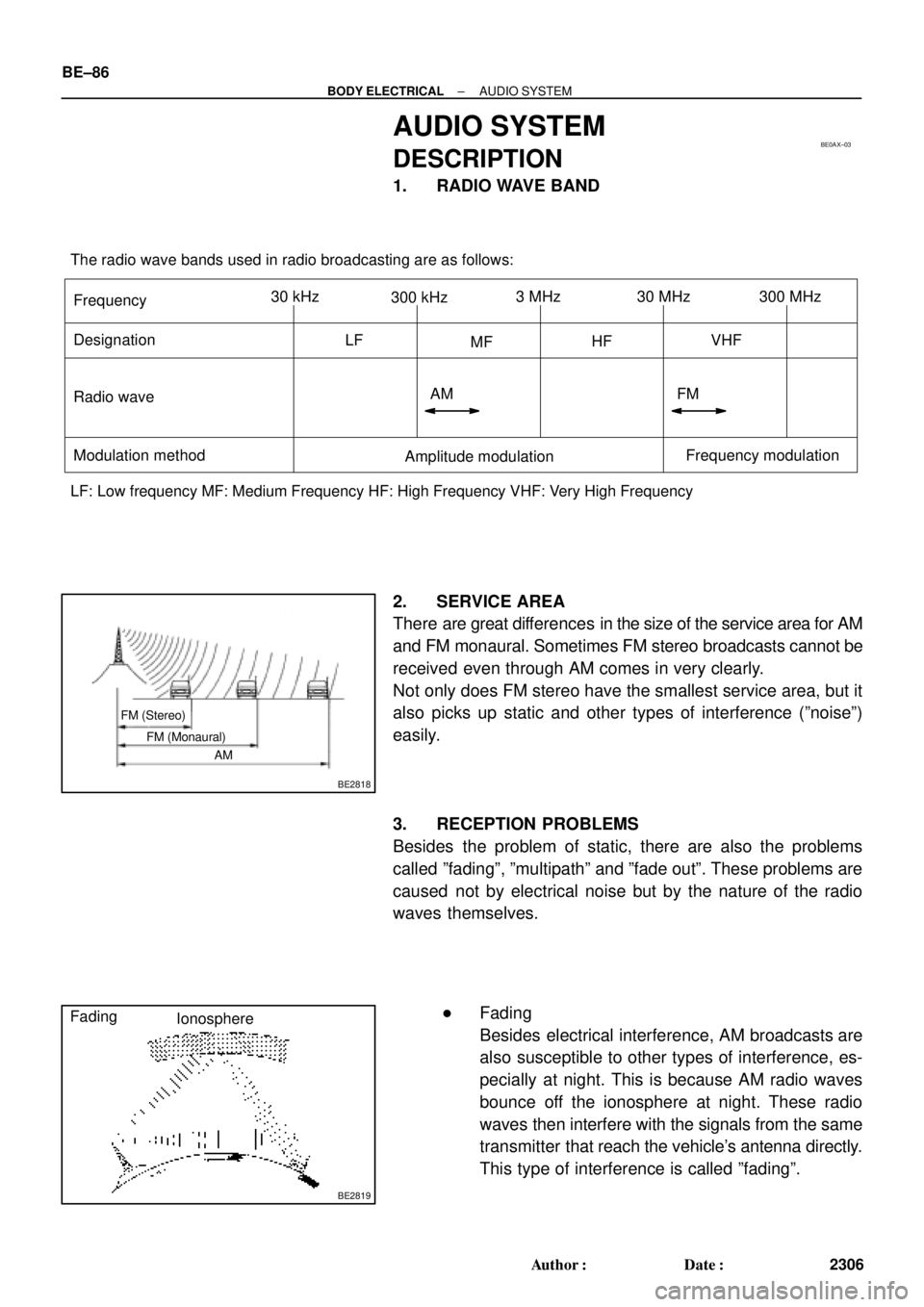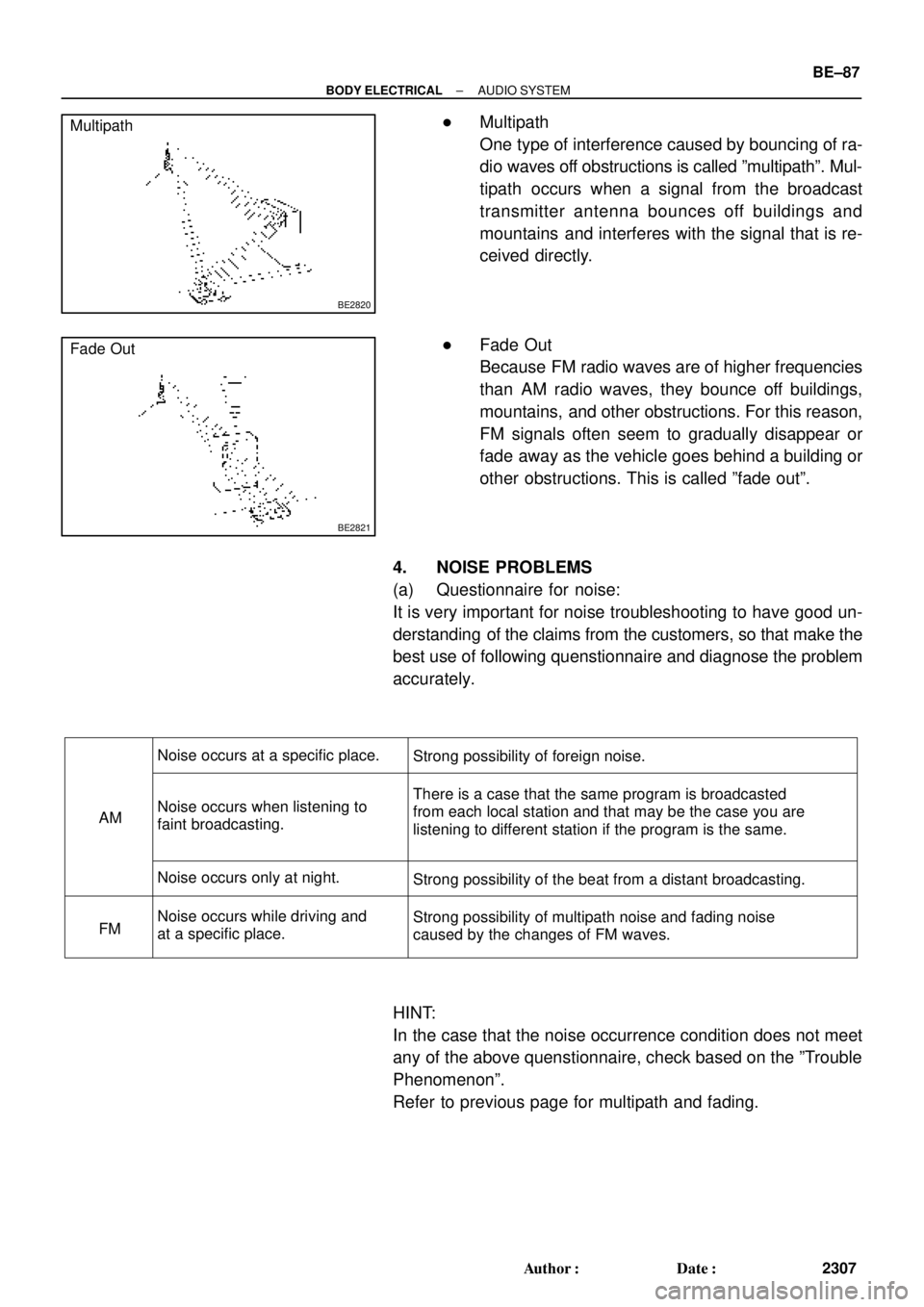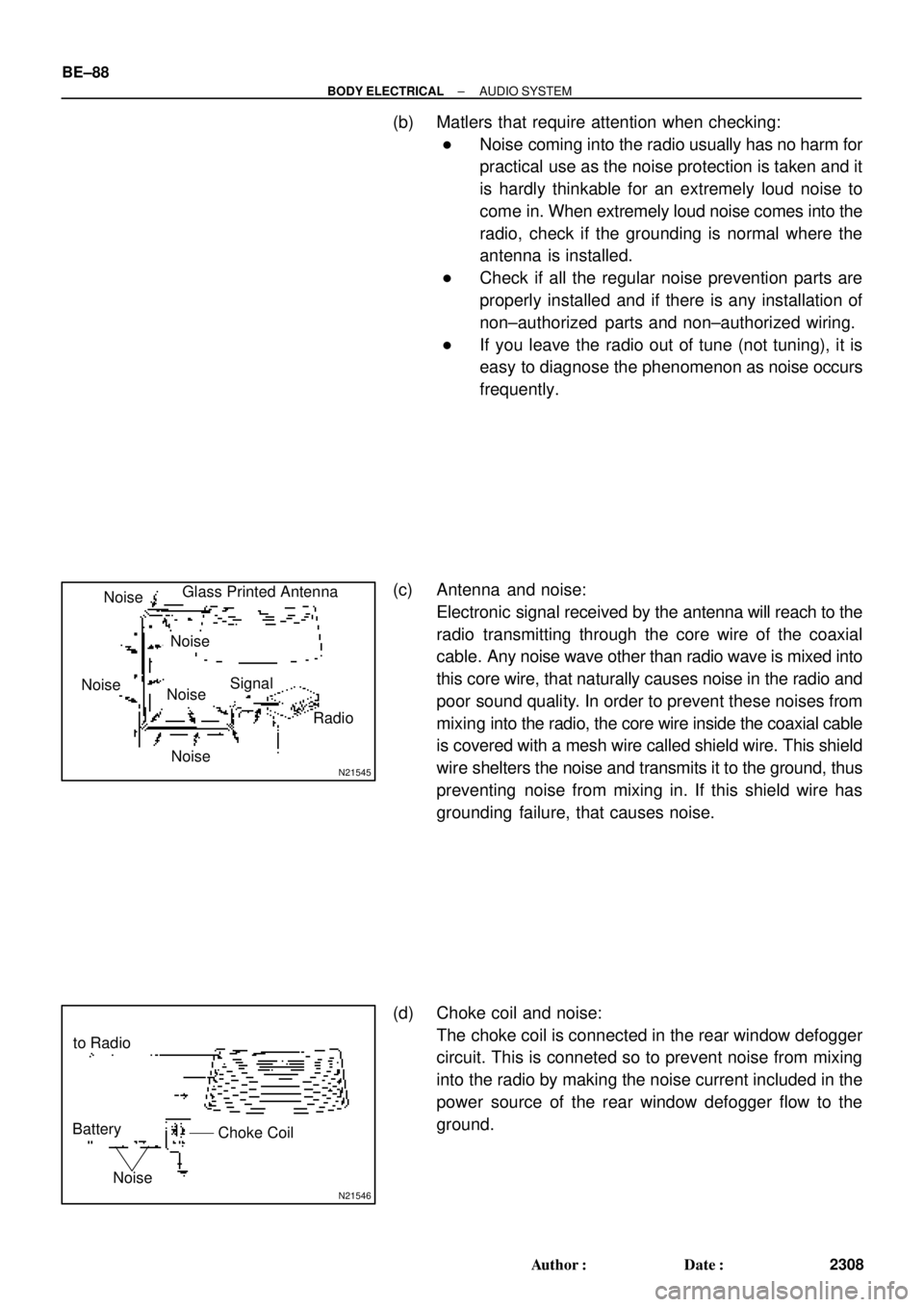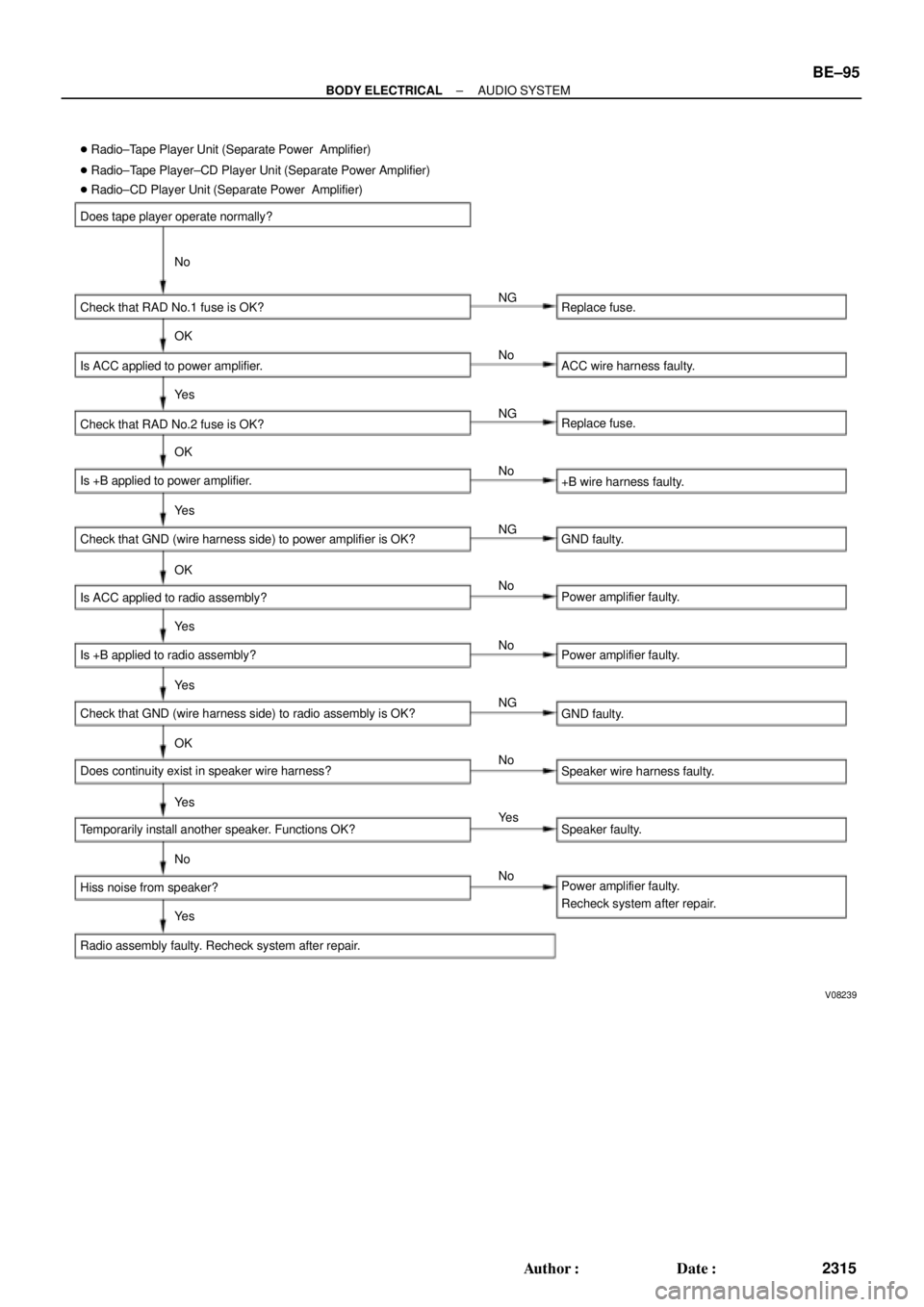Page 2180 of 4770

The radio wave bands used in radio broadcasting are as follows:
Frequency
Designation
Radio wave
Modulation method
LF: Low frequency MF: Medium Frequency HF: High Frequency VHF: Very High FrequencyAmplitude modulationFrequency modulation 30 kHz
300 kHz3 MHz 30 MHz 300 MHz
LF
MFHFVHF
AM FM
BE0AX±03
BE2818
FM (Stereo)
FM (Monaural)
AM
BE2819
Fading
Ionosphere BE±86
± BODY ELECTRICALAUDIO SYSTEM
2306 Author�: Date�:
AUDIO SYSTEM
DESCRIPTION
1. RADIO WAVE BAND
2. SERVICE AREA
There are great differences in the size of the service area for AM
and FM monaural. Sometimes FM stereo broadcasts cannot be
received even through AM comes in very clearly.
Not only does FM stereo have the smallest service area, but it
also picks up static and other types of interference (ºnoiseº)
easily.
3. RECEPTION PROBLEMS
Besides the problem of static, there are also the problems
called ºfadingº, ºmultipathº and ºfade outº. These problems are
caused not by electrical noise but by the nature of the radio
waves themselves.
�Fading
Besides electrical interference, AM broadcasts are
also susceptible to other types of interference, es-
pecially at night. This is because AM radio waves
bounce off the ionosphere at night. These radio
waves then interfere with the signals from the same
transmitter that reach the vehicle's antenna directly.
This type of interference is called ºfadingº.
Page 2181 of 4770

BE2820
Multipath
BE2821
Fade Out
AM
FMNoise occurs at a specific place.
Strong possibility of foreign noise.
Noise occurs when listening to
faint broadcasting.
Noise occurs only at night.
Noise occurs while driving and
at a specific place.There is a case that the same program is broadcasted
from each local station and that may be the case you are
listening to different station if the program is the same.
Strong possibility of the beat from a distant broadcasting.
Strong possibility of multipath noise and fading noise
caused by the changes of FM waves.
± BODY ELECTRICALAUDIO SYSTEM
BE±87
2307 Author�: Date�: �
Multipath
One type of interference caused by bouncing of ra-
dio waves off obstructions is called ºmultipathº. Mul-
tipath occurs when a signal from the broadcast
transmitter antenna bounces off buildings and
mountains and interferes with the signal that is re-
ceived directly.
�Fade Out
Because FM radio waves are of higher frequencies
than AM radio waves, they bounce off buildings,
mountains, and other obstructions. For this reason,
FM signals often seem to gradually disappear or
fade away as the vehicle goes behind a building or
other obstructions. This is called ºfade outº.
4. NOISE PROBLEMS
(a) Questionnaire for noise:
It is very important for noise troubleshooting to have good un-
derstanding of the claims from the customers, so that make the
best use of following quenstionnaire and diagnose the problem
accurately.
HINT:
In the case that the noise occurrence condition does not meet
any of the above quenstionnaire, check based on the ºTrouble
Phenomenonº.
Refer to previous page for multipath and fading.
Page 2182 of 4770

N21545
NoiseGlass Printed Antenna
Signal
Radio
Noise
Noise
Noise
Noise
N21546
to Radio
Battery
Choke Coil
Noise
BE±88
± BODY ELECTRICALAUDIO SYSTEM
2308 Author�: Date�:
(b) Matlers that require attention when checking:
�Noise coming into the radio usually has no harm for
practical use as the noise protection is taken and it
is hardly thinkable for an extremely loud noise to
come in. When extremely loud noise comes into the
radio, check if the grounding is normal where the
antenna is installed.
�Check if all the regular noise prevention parts are
properly installed and if there is any installation of
non±authorized parts and non±authorized wiring.
�If you leave the radio out of tune (not tuning), it is
easy to diagnose the phenomenon as noise occurs
frequently.
(c) Antenna and noise:
Electronic signal received by the antenna will reach to the
radio transmitting through the core wire of the coaxial
cable. Any noise wave other than radio wave is mixed into
this core wire, that naturally causes noise in the radio and
poor sound quality. In order to prevent these noises from
mixing into the radio, the core wire inside the coaxial cable
is covered with a mesh wire called shield wire. This shield
wire shelters the noise and transmits it to the ground, thus
preventing noise from mixing in. If this shield wire has
grounding failure, that causes noise.
(d) Choke coil and noise:
The choke coil is connected in the rear window defogger
circuit. This is conneted so to prevent noise from mixing
into the radio by making the noise current included in the
power source of the rear window defogger flow to the
ground.
Page 2185 of 4770

BE0AY±05
± BODY ELECTRICALAUDIO SYSTEM
BE±91
2311 Author�: Date�:
TROUBLESHOOTING
NOTICE:
When replacing the internal mechanism (computer part) of the audio system, be careful that no part
of your body or clothing comes in contact with the terminals of the leads from the IC, etc. of the re-
placement part (spare part).
HINT:
This inspection procedure is a simple troubleshooting which should be carried out on the vehicle during sys-
tem operation and was prepared on the assumption of system component troubles (except for the wires and
connectors, etc.).
Always inspect the trouble taking the following items into consideration.
�Open or short circuit of the wire harness
�Connector or terminal connection fault
ProblemNo.
RadioRadio not operating when power switch turned 'ON'.1
Display indicates when power switch turned 'ON', but no sound (including 'noise')
is produced.2
Noise present, but AM ± FM not operating.3
Any speaker does not work.4
Either AM or FM does not work, reception poor (volume faint), Fewer station pre-
sets.5
Poor reception.6
Sound quality poor.7
Preset memory disappears.8
Tape PlayerCassette tape cannot be inserted.9
Cassette tape is inserted, but no power.10
Power coming in, but tape player not operating.11
Either speaker does not work.12
Sound quality poor. (volume faint)13
Tape jammed, malfunction with tape speed or auto±reverse.14
Cassette tape will not be ejected.15
CD PlayerCD cannot be inserted.16
CD inserted, but no power.17
Power coming in, but CD player not operating.18
Sound jumps.19
Sound quality poor (Volume faint).20
Either speaker does not work.21
CD will not be ejected.22
NoiseNoise occurs.23
Noise produced by vibration or shock while driving.24
Noise produced when engine starts.25
The term ºAMº includes LW, MW and SW, and the term ºFMº includes UKW.
Page 2186 of 4770
1 Radio RADIO NOT OPERATING WHEN POWER SWITCH TURNED 'ON'
Does tape or CD player operate normally? Radio assembly faulty.
Check that RAD No.1 fuse is OK?
Is ACC applied to radio?
Check that RAD No.2 fuse is OK?
Is +B applied to radio?
Check that GND (wire harness side) to radio is OK?Replace fuse.
ACC wire harness faulty.
Replace fuse.
+B wire harness faulty.
GND faulty.
Radio assembly faulty.No
OK
Ye s
OK
Ye s
OKYe s
NG
No
NG
No
NG
�Radio±Tape Plater Unit (Built±in Power Amplifier) �Radio±CD Plater Unit (Built±in Power Amplifier) BE±92
± BODY ELECTRICALAUDIO SYSTEM
2312 Author�: Date�:
Page 2187 of 4770
I03349
� Radio±Tape Player Unit (Separate Power Amplifier)
� Radio±Tape Player±CD Player Unit (Separate Power Amplifier)
Does tape or CD player operate normally?
Check that RAD No.1 fuse is OK?
Is ACC applied to power amplifier?
Check that RAD No.2 fuse is OK?
Is +B applied to power amplifier?
Check that GND (wire harness side) to power amplifier is OK?
Is ACC applied to radio assembly?
Is +B applied to radio assembly?
Check that GND (wire harness side) to radio assembly is OK?
Radio assembly faulty.Radio assembly faulty.
Replace fuse.
ACC wire harness faulty.
Replace fuse.
+B wire harness faulty.
GND faulty.
Power amplifier or wire harness faulty.
Power amplifier or wire harness faulty.
GND faulty. No
OK
Ye s
OK
Ye s
OK
Ye s
Ye s
OKYe s
NG
No
NG
No
NG
No
No
NG � Radio±CD Player Unit (Separate Power Amplifier)
± BODY ELECTRICALAUDIO SYSTEM
BE±93
2313 Author�: Date�:
Page 2188 of 4770
I03350
2RadioDISPLAY INDICATES WHEN POWER SWITCH TURNED
'ON', BUT NO SOUND (INCLUDING 'NOISE') IS PRODUCED
� Radio±Tape Player Unit (Built±in Power Amplifier)
Does tape or CD player operate normally?
Check that RAD No.1 fuse is OK?
Is ACC applied to radio?
Check that RAD No.2 fuse is OK?
Is +B applied to radio?
Check that GND (wire harness side) to radio is OK?
Does continuity exist in speaker wire harness?
Temporarily install another speaker.
Radio faulty.Radio faulty.
Replace fuse.
ACC wire harness faulty.
Replace fuse.
+B wire harness faulty.
GND faulty.
Speaker wire harness faulty.
Speaker faulty. No
OK
Ye sNG
NoNo
No
No OK
OK Ye s
Ye sYe s
Ye s NG
NG � Radio±CD Player Unit (Built±in Power Amplifier) BE±94
± BODY ELECTRICALAUDIO SYSTEM
2314 Author�: Date�:
Page 2189 of 4770

V08239
� Radio±Tape Player Unit (Separate Power Amplifier)
� Radio±Tape Player±CD Player Unit (Separate Power Amplifier)
Does tape player operate normally?
Check that RAD No.1 fuse is OK?
Is ACC applied to power amplifier.
Check that RAD No.2 fuse is OK?
Is +B applied to power amplifier.
Check that GND (wire harness side) to power amplifier is OK?
Is ACC applied to radio assembly?
Is +B applied to radio assembly?
Check that GND (wire harness side) to radio assembly is OK?
Does continuity exist in speaker wire harness?
Temporarily install another speaker. Functions OK?
Hiss noise from speaker?
Radio assembly faulty. Recheck system after repair.Replace fuse.
ACC wire harness faulty.
Replace fuse.
+B wire harness faulty.
GND faulty.
Power amplifier faulty.
Power amplifier faulty.
GND faulty.
Speaker wire harness faulty.
Speaker faulty.
Power amplifier faulty.
Recheck system after repair. No
OK
Ye sNG
No
No No No No No No
OK
OK
OK Ye s
Ye s
Ye s
Ye s
Ye sYe s NG
NG
NG � Radio±CD Player Unit (Separate Power Amplifier)
± BODY ELECTRICALAUDIO SYSTEM
BE±95
2315 Author�: Date�: